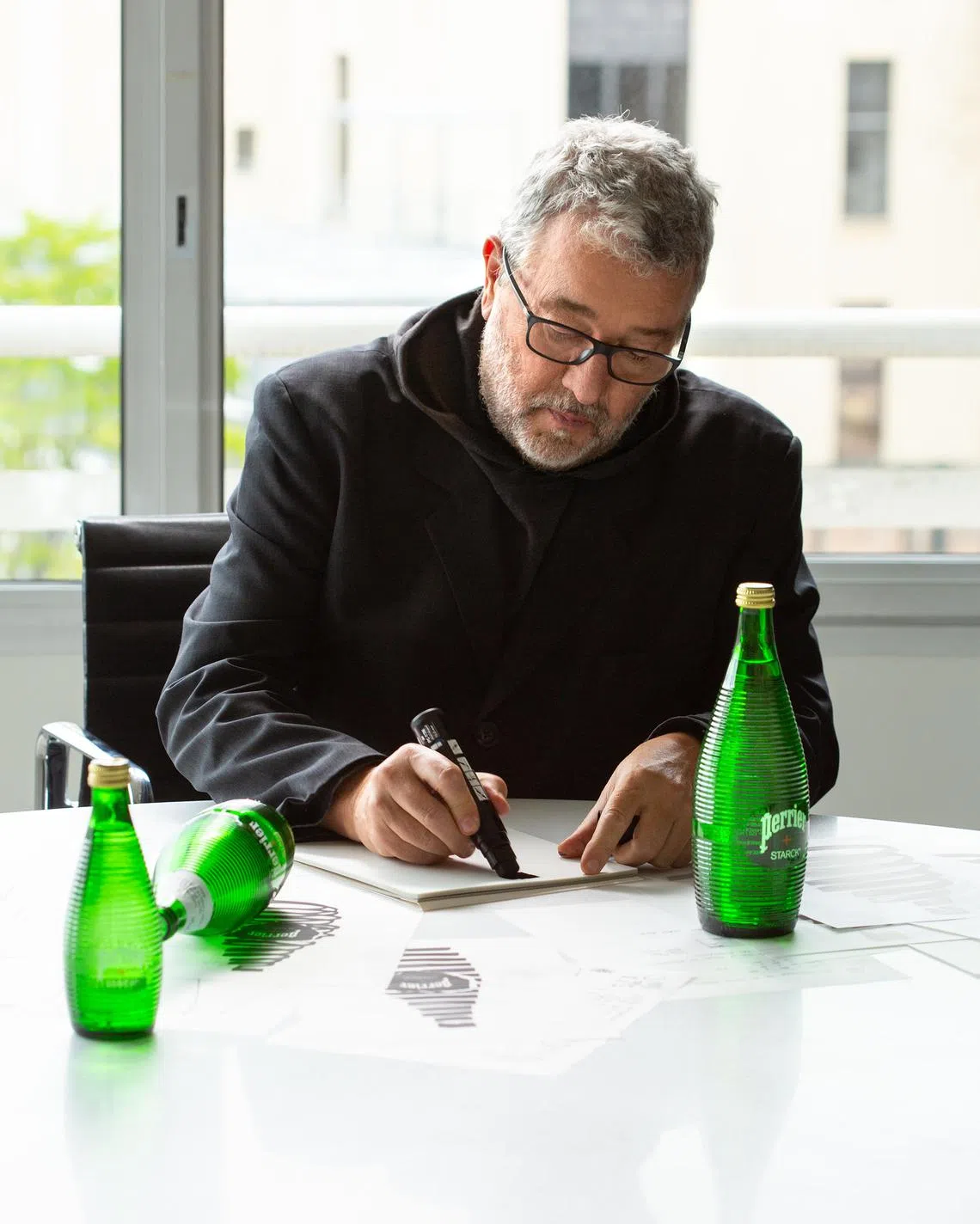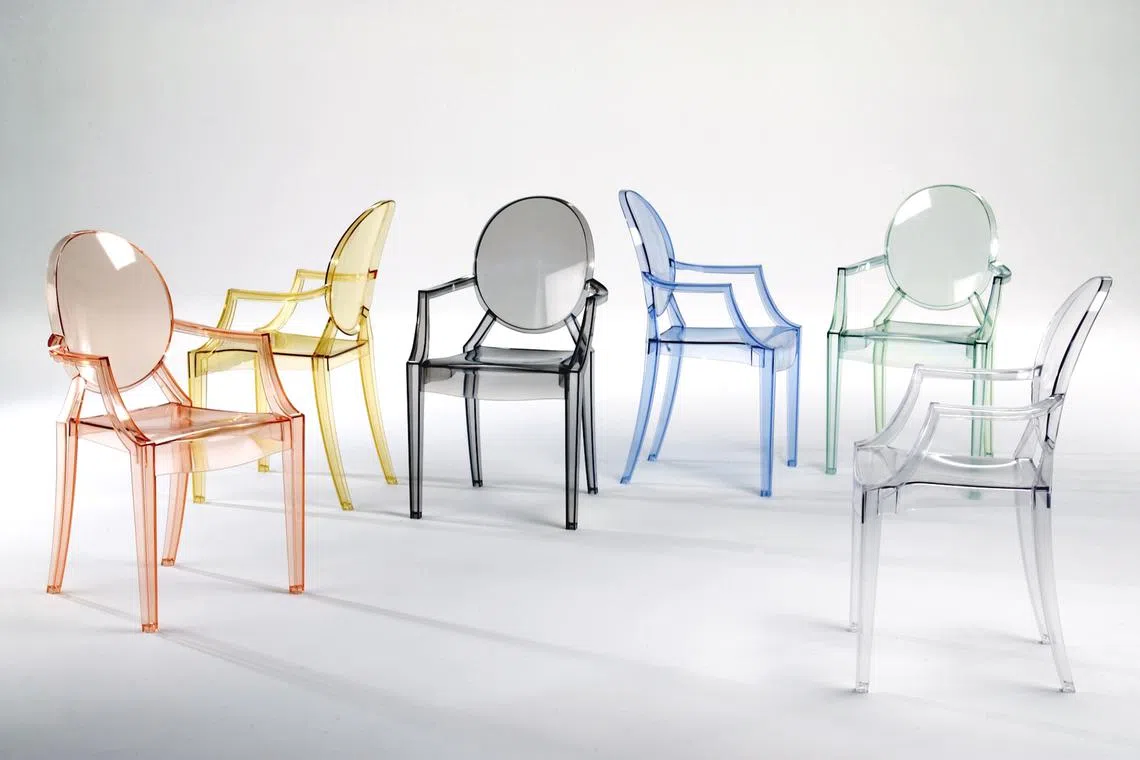Philippe Starck, designer of Louis Ghost chair and new Perrier bottle, hates trends
Sign up now: Get ST's newsletters delivered to your inbox

Renowned French architect and designer Philippe Starck says he is decidedly anti-trend.
PHOTO: ANNE-LOU BUZOT
Follow topic:
SINGAPORE – If Philippe Starck is a household name, it is probably because he has designed more household products than any other designer in the world.
He has designed furniture, home accessories, kitchen appliances, tech gadgets, tableware, clothing, bathroom accessories – the list goes on.
His curriculum vitae of accomplishments and accolades is more than 27 pages long, single-spaced.
Now, the 74-year-old French architect and designer can add the new glass bottles for Perrier, the French sparkling water brand, to his catalogue of designs.
The limited-edition bottles come in two sizes, 311ml and 727ml, and will be available in stores in Singapore at the end of November.

Perrier celebrates its 160th anniversary with a new limited-edition bottle called Perrier + Starck, designed by Philippe Starck.
PHOTO: PERRIER
In France, the small bottle costs €2.99 ($4.30) and the big bottle costs €3.69.
Prices for Singapore have not been released, but a regular 750ml glass bottle of Perrier costs $3.95, while a pack of four 330ml glass bottles costs $10.15 on FairPrice Online.
Starck’s accolades include Red Dot Design Awards and iF Design Awards – international design prizes that are recognised around the world as seals of excellence.
Speaking about the new bottle and the ethos of his practice, he reveals why he is a top designer: “I hate trends.”
His pairing with Perrier, which turns 160 in 2023, is fortuitous. The brand, too, has outlasted similar products that have come and gone.
It was in 1863 that a spring at Les Bouillens in Vergeze, France, was turned into a spa at the decree of French ruler Napoleon III (1808-1873). In 1898, Dr Louis Eugene Perrier became the spa’s chief medical director and decided to bottle the water for drinking.
The famous pear-shaped bottle was designed in 1906 by Britain-born John Harmsworth, founder and owner of the Perrier brand, who bought the spa in 1903.
The shape was inspired by the curves of the Indian juggling clubs that he used daily for exercise, and this shape has changed very little since.
While Starck was allowed to change the shape of the bottle, he decided not to “touch the iconic silhouette”, he says in a Zoom interview.
“I love timelessness and Perrier has proven it is one of the best examples of a timeless brand.”

While Starck was allowed to change the shape of the bottle, he decided not to “touch the iconic silhouette”.
PHOTO: ANNE-LOU BUZOT
What he did was enrich the design narrative of the bottle by making it even more French. He turned to another timeless design he admires: the Fresnel lens, developed in 1823 by French physicist Augustin-Jean Fresnel to increase the luminous range of lighthouses and make marine navigation safer.
The lens features a concentric pattern of carved ridges, a technique developed to channel a beam of parallel rays in the same direction.
“It’s an incredibly intelligent invention,” says Starck.
Inspired by the Fresnel lens, he added carved ridges to his bottle design. The ridges diffract light and create an optical illusion that accentuates the magical yet scientific effect of bubbles rising through carbonated water.
“Now you can see the bubbles through a Fresnel lens – making it more sophisticated and more surprising,” Starck adds.
“That was my main idea – a reference to the magic of science. I used the principles of diffraction, refraction and reflection to give an added emotional dimension to the bottle.”
“Some people may see my designs as extravagant, but for me, they are absolutely not extravagant. Sometimes it looks cuckoo, but it is not cuckoo. I design what I think. I am deeply honest.”
Starck also cares little that many of his designs, including the Juicy Salif (1988) lemon squeezer – which looks a bit like an alien spaceship and was produced by Italian home accessories company Alessi – are in the permanent collections of major institutions like the Museum of Modern Art in New York and the Victoria and Albert Museum in London.
“I have a lot of my designs in museums, but this is absolutely not my goal,” he says.
What Starck achieves with his designs is a sense that the product is elevated beyond its everyday function. For him, a chair is not just something to sit on.
Take, for instance, the baroque-inspired Louis Ghost (2002), which Starck designed for Italian furniture maker Kartell and has become one of the most popular designer chairs in the world.

The Louis Ghost is one of the world's most popular designer chairs, with around three million sold in a 2022 estimate.
PHOTO: KARTELL
In 2022, the 20th anniversary of its design, it was estimated that around three million chairs had been sold.
Starck explains that the Louis Ghost chair is about “dematerialisation and common memory”.
“It was designed (during the reign of) Louis XV and it became an archetype. That means I have not designed it. We designed it. And because we designed it, it is inside of us all and is timeless,” he adds. The French king ruled from 1710 to 1774.
Made from transparent polycarbonate injected into a single mould, it is a ghost of a chair.
“For me, everything is a continuum,” says Starck.
The designer also mines his subconscious for inspiration, as he did for the Perrier bottle.
So, while the magical and scientific quality of bubbles in carbonated water may seem overstated to some, for Starck, “I drink because I want something different, special and elegant – something sparkling. It’s in my subconscious”.
He adds: “As a child, my family would usually go and have lunch with my grandmother on Sundays. My grandmother was quite elegant, and over lunch, she would drink champagne.
“While she drank champagne, us children would be given Perrier in champagne glasses.”


